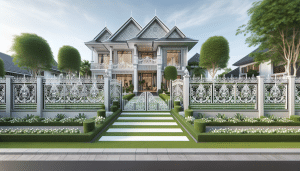At Savannah Gate & Fence, we’re passionate about crafting the perfect picket fence to enhance your home’s charm and security. You’re probably pondering which wood type best suits your needs, and you’re not alone! Many homeowners face the same dilemma, and we’re here to offer clarity. This guide delves into the best wood options for picket fences, ensuring you pick the perfect match.
Contents
- 1 Cedar: Nature’s Gift to Fencing
- 2 Durability of Redwood Fences
- 3 Pine: An Economical Choice
- 4 Understanding the Appeal of Cypress
- 5 Acacia: Strength in Simplicity
- 6 Comparing the Benefits
- 7 Pressure-Treated Wood: Pros and Cons
- 8 Exploring Exotic Woods
- 9 Environmental Considerations
- 10 Contact Us for Your Perfect Picket Fence
Cedar: Nature’s Gift to Fencing
Cedar has earned its reputation as a superb fencing material thanks to its inherent properties. The rich aroma and natural oils present in cedar make it naturally resistant to insects and decay. This means your fence will stand the test of time without requiring frequent chemical treatments.
Many homeowners are drawn to cedar for its beautiful, reddish-brown hue that gracefully ages to a silver-gray patina. This transformation can enhance your home’s aesthetic, blending effortlessly with many landscaping styles. A cedar picket fence is an attractive and practical choice.
Durability of Redwood Fences
Redwood is another excellent choice for those seeking both beauty and resilience. Known for its straight grain and rich color, redwood offers a stunning appearance that adds warmth to any yard. Like cedar, redwood contains natural tannins, providing a defense against pests and rot.
While it’s an investment, homeowners often find the lasting beauty and minimal maintenance needs well worth the expense. Your initial costs will reward you with years of satisfaction and a piece of art that enhances your home.
Pine: An Economical Choice
For those on a tighter budget, pine can be a practical solution. Often treated to withstand the elements, pine offers versatility and durability at a fraction of the cost of other woods. Its light appearance can be effortlessly painted or stained to match your home’s decor.
While it might not possess the natural pest-repelling oils found in cedar or redwood, treated pine can still provide years of dependable service. Its adaptability makes it a homeowner favorite for custom designs and styles.
Understanding the Appeal of Cypress
Cypress offers the allure of a natural resistance to decay and insects due to its inherent oils, similar to cedar and redwood. The wood’s characteristic color streaks, ranging from golden honey to dark chocolate, make it visually appealing.
Moreover, cypress is more affordable than some other options, adding an element of cost-efficiency without sacrificing quality. Its unique grain patterns and impressive durability make cypress a strong contender for your next picket fence project.
Acacia: Strength in Simplicity
Acacia might not be as commonly known, but its superior strength and resistance to the elements are noteworthy. The dense composition of acacia makes it highly resistant to scratches and dents, perfect for an environment with active kids or pets.
While it provides less environmental oil protection than some woods, its extraordinary strength compensates by withstanding direct impacts and pressure. This sturdy nature ensures acacia remains a viable and lasting choice for homeowners.
Comparing the Benefits
Let’s break down the benefits to help you make an informed choice:
- Natural Resistance: Woods like cedar and redwood are naturally pest-resistant, saving on future treatment costs.
- Visual Appeal: Each wood type offers unique grain patterns and colors, from the warm reds of redwood to the sleek silvers of aged cedar.
- Cost-Effectiveness: Options like pine and cypress provide budget-friendly alternatives without sacrificing quality.
- Durability: Stronger woods like acacia ensure long-term resilience even in active environments.
- Customization: Most woods can be stained or painted, offering a customizable palette to suit any homeowner’s taste.
Pressure-Treated Wood: Pros and Cons
When considering pressure-treated wood, it has its set of advantages and drawbacks. On the plus side, it’s highly durable, as the treatment process infuses chemicals that protect against rot and insects. This means longer life for your fence under extreme conditions.
However, some might view the chemical treatment process with caution. While modern treatments are safer than older methods, it’s crucial to understand and weigh potential environmental impacts. For those prioritizing strength with a blend of affordability, pressure-treated wood stands strong.
Exploring Exotic Woods
Looking for something a bit more unique? Exotic woods, though generally pricier, can provide unparalleled beauty and rarity. Woods such as teak or ipe, boast extraordinary durability and are famed for their rich, exotic hues.
These woods require less maintenance than local types, thanks to their dense grains and natural oils. While initial investment is higher, the statement they make is hard to rival, offering distinct appeal to discerning homeowners.
Environmental Considerations
When selecting your wood, consider environmental impact, especially if sustainability is important to you. FSC-certified woods ensure responsible forestry practices, making your choice eco-friendly.
Wood types that require fewer treatments can also lessen chemical reliance in your yard. Opting for sustainable sources and naturally resistant woods aids in preserving both the environment and our landscapes.
Contact Us for Your Perfect Picket Fence
Choosing the right wood for your picket fence is a critical decision, balancing aesthetics, durability, and cost. Allow us to guide you in picking the perfect wood that aligns with your vision. Contact us by phone at 912-800-0818 or Request a Free Quote today!




